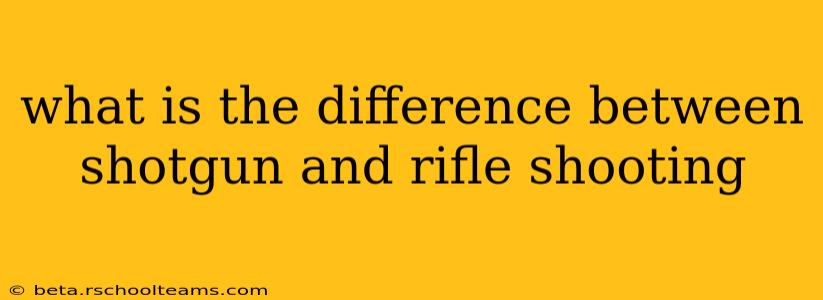Shotgun and rifle shooting, while both forms of firearm shooting, offer vastly different experiences and require distinct skill sets. Understanding these differences is crucial for choosing the right firearm and developing safe and effective shooting techniques. This article will delve into the key distinctions between these two popular disciplines.
Ammunition: The Core Difference
The most fundamental difference lies in the ammunition used. Rifles fire single projectiles, typically bullets, designed for accuracy and long-range precision. Shotguns, on the other hand, fire shot, which is a collection of small pellets or slugs. This key difference dramatically impacts the ballistic properties, effective range, and intended purpose of each firearm.
Rifle Ammunition: Precision and Range
Rifle ammunition is meticulously crafted for accuracy. The bullet's shape, weight, and the rifling within the barrel all contribute to its trajectory. This allows for longer-range shots with higher precision, making rifles ideal for hunting larger game at distance or for target shooting.
Shotgun Ammunition: Dispersion and Impact
Shotgun ammunition's defining characteristic is its spread. The shot pellets disperse in a cone-shaped pattern, making them effective at close to medium range. While less precise than rifles at distance, the wide spread makes shotguns excellent for hunting birds or close-quarters self-defense. Different types of shotgun ammunition, like slugs (single projectiles), buckshot (larger pellets), and birdshot (smaller pellets), further broaden its versatility.
Barrel Design and Rifling
Another critical distinction lies in the barrel design.
Rifle Barrels: Rifling for Accuracy
Rifle barrels feature rifling, spiral grooves cut into the barrel's interior. These grooves impart spin to the bullet, stabilizing its flight and enhancing accuracy. The tighter the rifling, the more spin, leading to greater accuracy at longer ranges.
Shotgun Barrels: Smoothbore for Dispersion
Shotgun barrels are generally smoothbore, lacking the rifling found in rifles. This smooth interior allows the shot to disperse effectively, maximizing the area covered by the shot pattern. However, some shotguns do use specialized slugs designed for rifled barrels to increase accuracy at longer ranges.
Shooting Techniques and Skill Sets
The shooting techniques and skill sets required for each firearm differ significantly.
Rifle Shooting: Precision and Control
Rifle shooting emphasizes precision and control. Proper stance, aiming, and trigger control are critical for accuracy. Often, aiming involves using sights or a scope for precise target acquisition. Consistent breath control and a smooth trigger pull are key to achieving consistent results.
Shotgun Shooting: Leading and Pattern Control
Shotgun shooting focuses on leading the target (anticipating its movement) and controlling the shot pattern. Because of the shot's dispersion, the shooter needs to account for the lead required to hit a moving target. Mastering the shotgun's swing and maintaining consistent patterns are crucial for effective shooting.
Applications and Uses
The applications of rifles and shotguns differ considerably:
Rifles: Long-Range Accuracy
Rifles are primarily used for long-range target shooting, hunting larger game (deer, elk, etc.), and competitive shooting. Their accuracy and range make them suitable for situations where precision is paramount.
Shotguns: Close-to-Medium Range Versatility
Shotguns are commonly used for hunting smaller game (birds, rabbits), home defense, and clay pigeon shooting. Their versatility in ammunition choice allows for a wide range of applications.
Conclusion
In summary, while both rifles and shotguns are firearms, their differences in ammunition, barrel design, and shooting techniques make them suitable for distinct applications. Choosing between a rifle and a shotgun depends entirely on the intended purpose and the shooter's skill level and preferences. Understanding these fundamental differences ensures safe and effective handling of both types of firearms.
